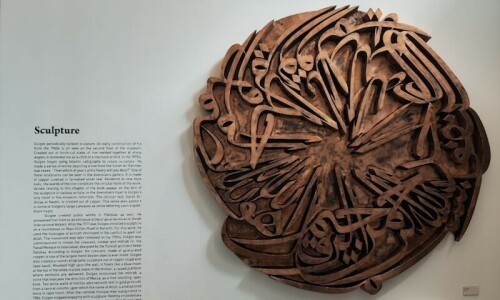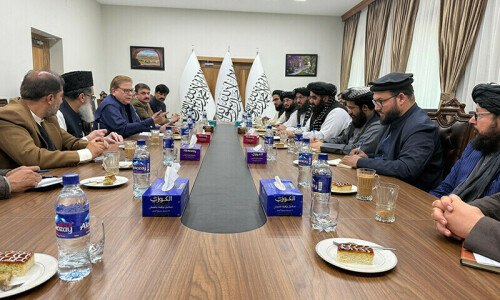A STRING of data releases in the previous week might suggest that the country has turned the corner. This is partially true. But it’s the other part, not covered by these data releases, where the problems really reside.
Consider three separate data and information points. The latest inflation reading shows its growth rate has dropped to single digits finally. The trade deficit declined on both a year-on-year basis as well as month-on-month. Last but not least Moody’s upgraded the country’s credit rating to CAA2 citing “Pakistan’s improving macroeconomic conditions and moderately better government liquidity and external positions, from very weak levels”. This still keeps the rating within junk territory, just a little less junky, that’s all.
So let’s consider these data points first. It is entirely normal for inflation to subside and the trade deficit to contract after a year of taking IMF medicine, which Pakistan has been doing since July 2023. Let’s pause here to note that high interest rates have played the decisive role in bringing the raging inflationary fire under control, although it took historic high rates for a prolonged period of time before this could happen.
Once the trade deficit contracts, the foreign exchange reserves usually stabilise automatically, since the trade deficit is the most important drain on the reserves.
As evidence just consider that Pakistan’s net reserves have risen slowly from $8.1 billion in July ’23 when they were replenished via an emergency deposit from the UAE and an IMF tranche totalling around $4bn, to $9.4bn today. Meanwhile the trade deficit has remained more or less confined too, which means import cover has been stable for the past 13 months or so.
Some indicators are showing an improvement, but the risks are still very much there.
If reserves are stable and the trade deficit is confined, the credit rating almost automatically goes up a notch. This happens every time when an IMF programme is being implemented, or as in the present case, the country is more or less keeping its macroeconomic settings within the parameters set by the IMF in the post-programme scenario.
So yes, some indicators are showing an improvement, and it can perhaps be said that the country has turned a corner in its extended macroeconomic adjustment underway for more than 13 months now, meaning the pain is bottoming out. But the risks are still very much there.
For now Pakistan’s big risk is that the country can return to the bad old days when cries of “default” were heard on the nightly talk shows every night. This was the summer of 2022 and 2023. Both times a hurriedly negotiated IMF programme came to the rescue. Had that not happened, Pakistan would undoubtedly have gone over an edge that we do not wish to contemplate. I often tell friends and acquaintances that “we dodged a bullet back then” and should be grateful for the hard-won period of calm that we have seen over the past 13 months.
But it is one thing to be grateful and entirely another to be complacent. The indicators mentioned earlier — inflation, trade deficit, rating upgrade — could easily turn negative once again, marking a return to the bad old days of drifting towards the edge of default. Even now, as the stabilisation phase appears to be bottoming out, revenue collection figures have shown a shortfall of Rs98bn, which is probably understated given the withheld refunds the tax authority is holding on to. This is too large for so early in the fiscal year, and could suggest further tax measures to come in the months ahead.
At the same time, the government’s latest attempt to net traders and wholesalers is faltering, prompting the finance minister to take to the air with a highly unusual recorded statement urging them to please step forward and make their contribution so industry and salaried people are not burdened further. Appeals of this sort are not likely to work. The finance minister is up against a decades-old compact between the state and informal sector services players which basically allowed them to grow up outside the tax net in return for not harbouring any expectations of participating in the formal sectors’ system of redistribution through subsidised credit schemes or energy provisioning or licensing barriers to entry into their trade. Retooling this compact in such a short span of time is a much tougher task than appeals to conscience might suggest.
Very importantly, the Punjab government’s attempt to subsidise electricity bills in the province has hit a snag. According to published reports, it turns out they had not calculated the full cost of this exercise properly. The first to point this out was their own finance minister, in on-record remarks given to the press, in which he said the subsidy will cost Rs90bn, almost double what his own chief minister had said the scheme would cost. He went on to say that half of this cost would be borne by the provincial government and the other half by the centre, which naturally raised questions about the subsidy being “fiscally neutral” as had been claimed earlier.
Now we have reports that in addition to the financing gap, the IMF is also examining this subsidy and its impact on the budget.
So even before the Fund programme has begun, even before the Staff-Level Agreement can be forwarded for approval to the Executive Board, it has run into a plethora of problems. The adjustment envisioned in the programme is inspiring opposition from civil society, making it necessary for the finance minister to make televised appeals.
At least one wing of the ruling party, the one in charge of the largest provincial government in the country, is chafing enough at the terms to seek ways out of the agreement. And the country’s creditors are raising questions about the ability of the government to walk the path it has committed to before they yield up further help to plug any external financing requirements of the programme. And all this just to get to the start line.
The writer is a business and economy journalist.
Published in Dawn, September 5th, 2024


















































Dear visitor, the comments section is undergoing an overhaul and will return soon.